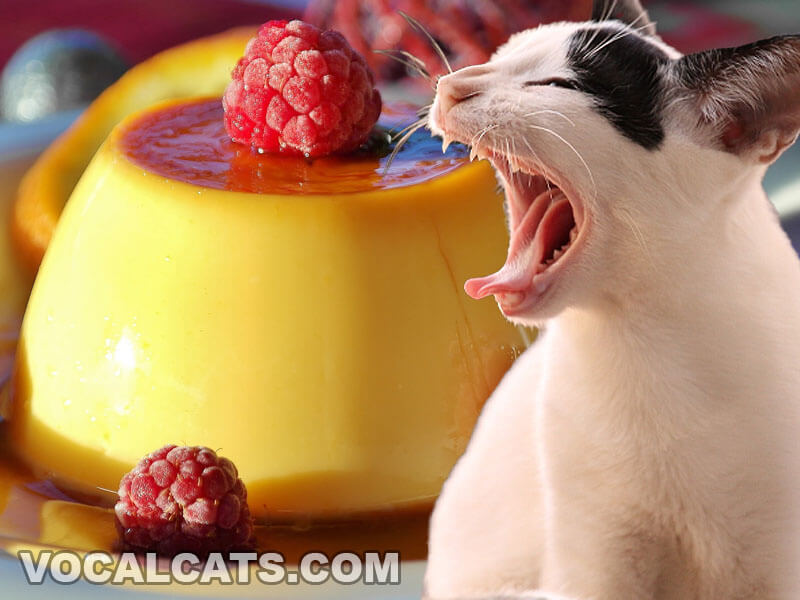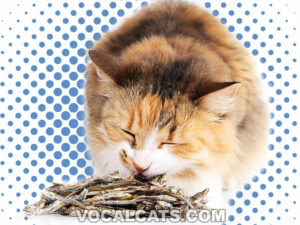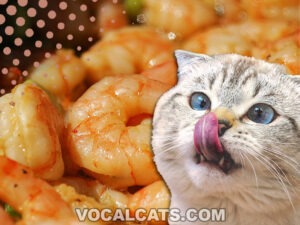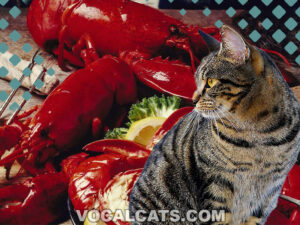Can cats eat Flan? No, cats should not eat Flan as this sweet and soft dessert is packed full of sugar, sodium carbohydrates, and fat. It’s best to keep this high-calorie Flan dessert away from your fur babies to avoid health problems such as feline-obesity, dental issues, salt poisoning or even vanilla extract poisoning. Also, since most felines are lactose intolerant, the amount of milk found in Flan could lead to digestive issues in cats.
If there is one thing cat lovers can all agree on, it’s that cats love treats. They will do just about anything to get their paws on something delicious. So, when you’re eating a yummy slice of Flan, you may find your furry friend suddenly invading your personal space and giving you those “feed me” eyes. Many of us may give in and hand over the goods, but you should stop to think: can cats eat Flan?
Contents
- Can cats have Flan?
- Is Flan bad for cats?
- Is Flan okay for cats?
- Nutritional value of Flan
- What if my cat accidentally ate Flan? What will happen? What should I do?
- Symptoms to Watch For
- Treatments if your cat has food poisoning from Flan
- So, is Flan safe for cats?
- Do cats like Flan?
- Can cats eat leche Flan?
- What are some feline-friendly and safe non-toxic Flan alternatives?
- So, can cats eat Flan?
Can cats have Flan?
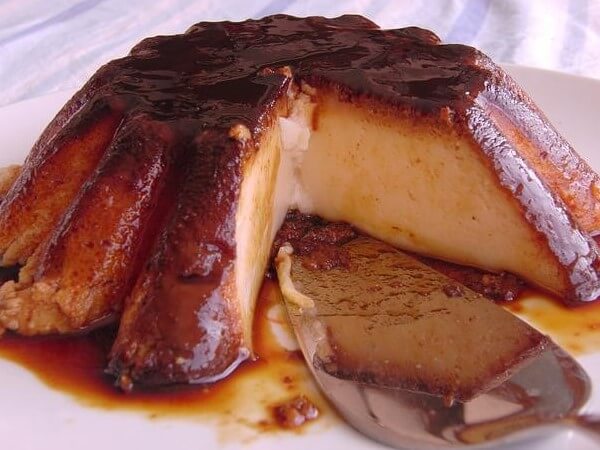
No, cats should not have Flan. No matter how sad or cute your fuzzy friend looks when begging for your delicious Flan treat, the ingredients in Flan as well as its nutritional profile is quite harmful to your cat’s health.
But what is it about Flan that makes them so dangerous to cats?
Well, as mentioned above, there are some ingredients in Flan that could harm your feline companion. Sugar is most likely the most harmful as our furry friends have no natural need for sugar or carbohydrates and their bodies do not know how to process and digest it properly.
To fully understand why cats should not have Flan, let’s take a quick look at what Flan is and the ingredients in this sweet dessert.
What is Flan?
Flan is a popular, delicious, Latin dessert. In the US, this savory treat is often called crème caramel or Flan de leche. Many might top this creamy custard dessert with a rich clear caramel sauce.
Everyone everywhere just can’t seem to get enough of this scrumptious delight. Which is probably why our cats can’t seem to resist it either!
What is Flan made of?
There are different ways to make Flan, but the dish does have the same typical ingredients no matter how you decide to make it.
There are a few ingredients in Flan that are quite harmful to your fur baby. The dessert is made with milk, which alone can give your kittens digestive issues. Even if they are able to digest it, the amount of sugar in Flan can be terrible for your cat’s health.
Flan can be made with just five simple (5) ingredients and they are:
Flan ingredients
- Eggs.
- Sweetened condensed milk.
- Whole milk.
- Sugar.
- Vanilla Extract.
- Caramel (optional).
Is Flan bad for cats?
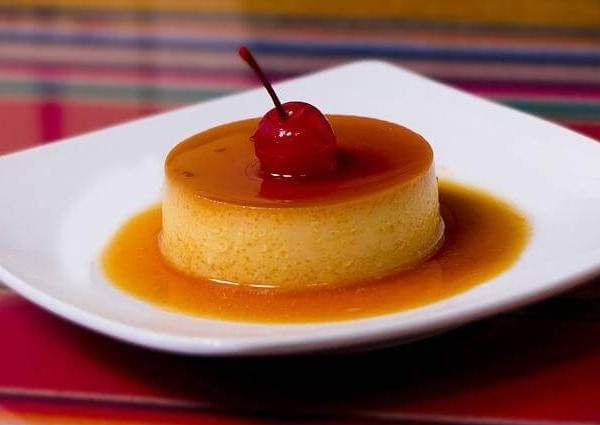
Yes, Flan is bad for cats for a number of reasons.
First, most cats are lactose intolerant. This means that our feline friends cannot digest dairy products properly. If your furry friend is lactose intolerant and drank milk, he may experience symptoms such as abdominal discomfort, constipation, flatulence, bloating, or even diarrhea.
That’s because our kitty cat’s body lack the lactase enzyme that is responsible for digesting or breaking down lactose, the sugar found in dairy products such as milk.
Additionally, there’s tons of sugar in Flan and high sugar consumption is especially bad for our little furballs.
In fact, most of the ingredients in Flan are potentially harmful to our fuzzy friends.
Regularly consuming Flan can lead to health issues including obesity, diabetes, and dental issues.
For these reasons, Flan is very bad for cats. No matter how much they beg for a piece of that scrumptious creamy treat, it’s not a good idea to offer it to them so don’t hand it over.
Before we dive into the nutritional value of Flan, let’s take a look at each of the ingredients in Flan and find out how they can negatively impact your fuzzy kitten’s health.
Is Flan okay for cats?
Eggs in Flan is safe for feline consumption
A great source of protein and fat, eggs alone will not harm your feline companions. As carnivores, a cat’s diet consists of animal-based protein. So, eggs won’t do much harm to your little kitties as long as it’s not the sole dietary source of protein for them. Keep in mind that eggs are more of a supplementary protein source.
The egg whites are the best part for your kittens since they contain protein without the fat. It’s important to note that egg yokes do contain fat, but a small amount won’t do much harm.
Sweetened condensed milk and whole milk in Flan are both harmful to cats that are lactose intolerant
Despite the popular belief that cats love milk, it is entirely false. You should never let your feline family member drink milk or other dairy products or substances.
It may appear that our four-legged friends love to drink milk, but all feline owners know that our cats will drink and eat anything they can get their paws on even if it’s bad for them.
It’s important to note that most cats are lactose intolerant. This means that they do not have the lactase enzyme in their intestines to properly break down or digest the lactose sugar that is found in whole milk or even sweetened condensed milk.
This may sound surprising as you probably know that kittens need their mother’s milk until they are at least four to five weeks old. So why is it fine for kittens to drink their mother’s milk but not whole milk or even sweetened condensed milk?
That’s because after birth and during the first 12 weeks of a kitten’s life, their body has enough lactase enzyme to properly break down the lactose sugar found in their mother’s milk. Once the kittens start to wean and grow in their pearly white teeth, they will start to start solid food. This is when they will also loose that lactase enzyme.
Additionally, there are more lactose sugar and casein (a milk protein) in a cow’s milk than in the milk of the mother cat.
Here are several other reasons why milk is generally unhealthy for our little furballs.
- Cow’s milk aren’t actually healthy for our cats. Cow’s milk does not contain all the essential nutrients that our cats need.
- Cow’s milk (whole, skim, or 2%) have fats in them, which would add an unnecessary amount of fat to your felines’ diet which they don’t need. Increase fat intake can lead to an upset stomach in the short term and weight gain in the long run.
- Cats don’t actually need dairy milk.
- After digesting the milk, any undigested lactose will stay in their intestines and start to ferment.
- Sweetened condensed milk contains sugar that our cats don’t need.
Signs and symptoms of lactose intolerance in cats include:
- Vomiting.
- Diarrhea.
- Dehydration.
- Gastrointestinal upset.
- Flatulence.
- Upset stomach.
- Abdominal pain.
- Loss of appetite.
- Increased scratching.
READ ALSO: Do Ragdoll Cats Scratch Furniture?
As a result, it’s best to keep Flan away from your furry friends. If you notice changes in behavior or any of the symptoms above, we highly advised that you contact your vet.
Sugar in Flan can lead to diabetes and weight gain in cats
When it comes to sugar or sweet treats, it should be noted that our four-legged friends do not need or require sugar in their daily diet. In fact, cats can’t taste sugar or sweetness at all because they don’t have the taste buds that detects sugar.
This means that our kittens don’t have much of a sweet tooth and aren’t really attracted to sweet food or treats.
As a matter of fact, sugar should not exceed 3% of your feline’s daily diet.
Therefore, giving your fuzzy friends a piece or two of Flan on a regular basis is unnecessary and doing so would only harm their health. Too much sugar consumption can lead to diarrhea, vomiting, diabetes, obesity, digestive problems, and even periodontal disease such as cavities, tooth decay, gingivitis, and other dental diseases.
When cats are overweight due to high sugar consumption, it can provoke other health problems such as:
- Liver failure.
- Bladder stones.
- Urinary inflammation.
- Diabetes mellitus.
- Cardiovascular disease.
To keep your feline friends healthy, their natural diet should consist of mostly high amounts of animal-based protein and a good balance of amino acids, fatty acids, vitamins, minerals, carbs, and fat.
Vanilla Extract can cause alcohol poisoning in cats
Our feline family members should stay away from any food or treats that contain vanilla extract in them. Vanilla extract is made by steeping vanilla beans in water and ethyl alcohol. This helps give the vanilla extract that warm aromatic fragrance and amber-colored liquid.
Most will use pure vanilla extract in their Flan and to be considered a pure vanilla extract, it should contain a minimum of 100 grams of vanilla beans and at least 35% alcohol.
This high level of alcohol content is extremely dangerous for cats as it can cause alcohol poisoning.
Signs and symptoms of alcohol poisoning or ethyl poisoning from vanilla extract include:
- Frequent urination.
- Poor reflexes.
- Internal cell damage.
- Slow heart rate.
- Liver failure.
- Nervous system slowing.
If you notice signs of alcohol poisoning or ethyl poisoning in your furry friends, we highly recommend that you call your vet right away or your local poison helpline. This requires immediate medical attention and your vet may ask that you bring your feline friends in for a physical check up or examination.
Nutritional value of Flan
Nutritional profile of Flan (0.5 cup or 153g)
| Name, Unit | Amount |
| Calories, cal | 222 |
| Sugar, g | 35 |
| Sodium, mg | 81 |
| Carbohydrate, g | 35 |
| Total Fat, g | 6.2 |
| Saturated Fat, g | 2.8 |
| Potassium, mg | 181 |
| Protein, g | 6.9 |
As we can see, just 0.5 cups or 153 grams of Flan has about 222 calories, 6.2 grams of fat (2.8 grams saturated), and 35 grams of carbohydrate (35 grams of sugar). Let’s not forget the 81mg of sodium!
These numbers are shocking.
The amount of calories a cat should eat in a day varies depending on his or her weight. But the average cat should only weigh about 10 pounds. However, some breeds may be lighter (like a 5-pound Siamese cat) or may be heavier (like the Maine Coon cat at 25 pounds).
A 5-pound adult cat should only receive 156 calories a day. While a heavier 20+ pound adult cat should only 439 calories per day. Since the average weight of a domestic cat is 10 pounds, he or she should only receive 262 calories a day.
The amount of calories in just 0.5 cups or 153 grams of Flan would almost exceed the daily calorie limit of a 10 pound cat and this leave very little calories intake from their regular healthy cat food. In this way, most of the calories they receive would be coming from unhealthy food like Flan instead of their healthy meal.
Based on this information, we can say for certain that Flan is definitely not healthy for your cat. Even if it didn’t come with health risks, it wouldn’t do your cat any favors when it comes to dietary requirement and their daily calorie intake.
With all that sugar and fat, you’ll be putting your little furballs at risk of feline-obesity, diabetes, and digestive issues. For all these reasons, it’s best to keep Flan away from your kittens.
What if my cat accidentally ate Flan? What will happen? What should I do?
Even when we stand our ground and refuse to give in to our four-legged friends’ constant staring and begging, if they are determined enough, they will get that Flan.
Either by waiting for you to walk away so they can sneakily grab a bite or by outright snatching it from your plate. Believe us, cats have ways of getting what they want. In any event, don’t panic or cause any stress to your feline family member.
You’ll first want to find out how much Flan your cat has consumed. Did they consume half of a slice of Flan or just a few bite?
If they only ate a little bit of Flan, then most likely there won’t be any issue. You’ll still want to keep a close eye on your kitties for at least 24 hours and watch for any changes in behavior or for any symptoms.
If your furry friends consumed a lot of Flan, then you should take them to the vet or a nearby veterinary hospital as soon as possible. Large amounts of Flan consumption could lead to a multitude of health problems including mild diarrhea and pancreatitis.
Symptoms to Watch For
Whether your fuzzy kittens only had a nibble or gobbled down the whole thing, it is vital that you know what symptoms to watch out for.
Vomiting and diarrhea. The obvious sign that your little furballs have consumed something they shouldn’t. Vomiting and diarrhea is their bodies’ way of removing and getting rid of all the bad food.
Dehydration can occur due to frequent vomiting and diarrhea. If you notice your fuzzy friend vomiting or having a diarrhea, make sure a bowl of fresh cool water is nearby and accessible to him to keep him hydrated.
Lethargy. When your feline friend is feeling sick, he will have little to no energy. It may be hard for you to tell if your cat is lethargic, or if he’s just being your typical lazy cat. However, if he has no interest in playing with toys or eating treats (the big giveaway to when something is wrong), then he may be feeling lethargic.
Loss of appetite and weight loss. Another big red flag is when your cat starts to lose interest in food. We all know how much our feline companions love their food. If they suddenly aren’t eating anything and losing a lot of weight, they need to be seen by a vet as soon as possible.
Kidney Failure. The dehydration, vomiting and diarrhea can cause your cat to lose most of their bodily fluids. This could result in acute renal failure in your cat. If caught in time, it can be reversed. But chronic kidney failure is a lot harder to treat.
With all these in mind, it is very important that you do not waste any time when deciding whether to take your cat to the vet after eating Flan. Leaving him alone for too long without any immediate action can cause these problems to build to the point of no return. No one wants a tasty dessert to be the cause of their kitty’s passing.
Treatments if your cat has food poisoning from Flan
If your cat is fine after 24 hours, it is good news as most likely your furry friend did not consume enough Flan to cause sickness. However, if your cat is showing any of the symptoms we’ve mentioned above, there are steps you can take and ways to treat it.
The first step is to treat the vomiting and diarrhea. You’ll want to feed him an easily digestible diet such as boiled rice with some white fish, chicken or turkey. It’s best to feed them to your kitties in small portions and often throughout the day. It should equal to the amount you usually give your cat every day but just spread out into smaller portions.
A diet that is easy on the cat’s digestive system is more likely to stay inside your cat’s stomach long enough to go through its natural course.
Second, it’s crucial to keep your fuzzy friend hydrated and make sure they have easy access to plenty of clean, fresh water. This is vital to your cat’s health and a hydrated cat is a happy cat.
If your furry friend is an outdoor cat, it is best to keep him indoors so he can be supervised or monitored for a few days until he gets better.
If your cat has no interest in eating at all or has becomes lethargic, we highly recommend that you take him to the vet immediately to get checked over by a professional and follow their advice accordingly.
So, is Flan safe for cats?
Flan is safe for cats in that there are no toxic ingredients in this creamy dessert. However, there are ingredients in Flan like milk, sugar, and and vanilla extract that are harmful to your cat’s health.
While a tiny amount of Flan should be fine for cats, the ingredients above can actually upset your cat’s stomach and make him sick. Therefore, it’s best to keep Flan out of your kittens’ reach.
There is too much sugar, sodium, carb, and calories in Flan, which can negatively impact your feline friend’s health both in the short term and over the long run.
As we can see, a sweet tasty dessert like Flan is certainly not worth risking your cat’s life over.
Do cats like Flan?
To our cats, Flan appears to be like any other food. And when it comes to food, our furry friends will eat anything and everything we hand over to them.
However, not all food is healthy for our cats and this includes Flan. While cats would eat Flan (or any other food) if you offer it to them, it doesn’t mean that they like Flan.
Flan is a sweet and sugary treat, but our furry companion don’t have the tastebuds to can’t even taste and appreciate the sweetness of this dessert. Therefore, it’s most likely that cats will eat Flan since it is food but not because they like Flan.
Can cats eat leche Flan?
If your cat is lactose intolerant, then no, cats should not eat leche Flan. The name Leche Flan translates to “milk custard.” Leche Flan has more eggs and milk included in the ingredients for a much more creamy dessert.
Therefore, it’s best that our kittens don’t eat leche Flan and stay away from it. Leche Flan contains a higher amount of all the ingredients we’ve mentioned above that’s potentially harmful to your feline friends. As mentioned, cats are lactose intolerant and the more dairy there is in a dish, the more harmful it is to the cat.
Not to mentioned that Leche Flan contains more calories, carbs, sugar, fat, and sodium than the regular Flan. For these reasons, cats should not eat leche Flan.
What are some feline-friendly and safe non-toxic Flan alternatives?
There are some feline-friendly options you could give your cat instead of Flan if you can’t bare to look at those “feed me” eyes any longer.
Sugar-Free Flan
The sugar-free option of Flan includes unsweetened almond milk and eggs. Since cats can’t taste sugar or sweets, there’s no need to add any sugar in the homemade Flan.
Blue Buffalo Bursts
These are healthy cat treats with wholesome ingredients, no artificial colors, flavors or preservatives. Come with both crunchy and creamy fillings, and use real chicken liver and beef. If this doesn’t satisfy your cat, then nothing will!
Whole Life Pet Products Healthy Cat Treats
Just as it says on the tin, (or bag in this case), these are deliciously healthy treats for your cat. Made with the highest quality standards and micro-tested for any harmful bacteria. There are no artificial ingredients, preservatives, fillers, chemicals or salt. Simply 100% pure chicken. Another treat that will keep your cat happy and healthy.
So, can cats eat Flan?
Throughout this article, we have mentioned that cats should not eat Flan. Sure, one bite won’t hurt. But we all know that cats aren’t going to stop at one bite. When cats consume large amount of Flan, it can negatively affect their health both in the short term and in the long run.
A yummy dessert like Flan is not worth risking your cat’s health over. Instead, try giving your kitty cats some of the delicious treats we’ve recommended above. They are healthy, tasty and, most importantly, are made for cats.
DISCLAIMER: THIS WEBSITE DOES NOT PROVIDE MEDICAL ADVICE
The information, including but not limited to, text, graphics, images and other material contained on this website are for informational purposes only. No material on this site is intended to be a substitute for professional veterinary advice, diagnosis, or treatment. Always seek the advice of your veterinarian or other qualified health care provider with any questions you may have regarding dietary needs.
Resources:
https://en.wikipedia.org/wiki/Cr%C3%A8me_caramel
https://www.wikihow.com/Make-Flan
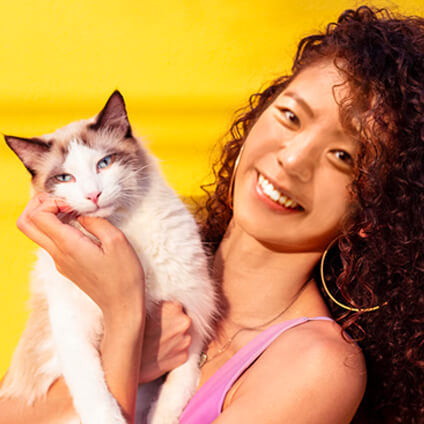
With over five years of specialized experience as an animal writer, my expertise lies in cat nutrition, health, behavior, grooming, and training. I am dedicated to delivering helpful and informative content that caters to the well-being of our feline friends. My primary goal is to empower pet owners with knowledge and ensure our feline companions thrive in health and happiness. In my free time, I love volunteering at local cat rescue centers.
